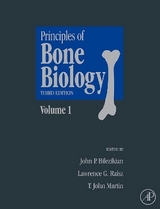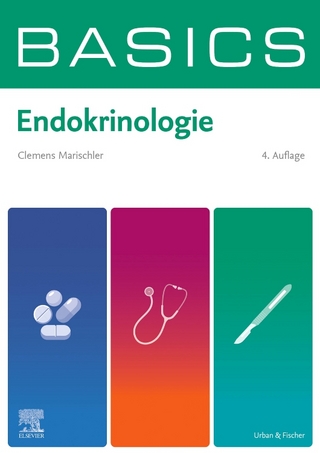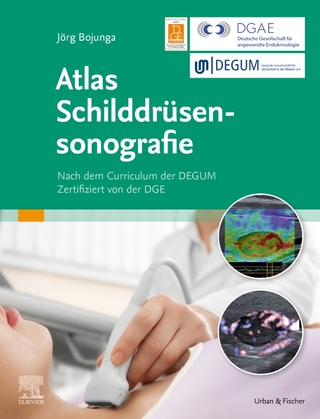
Principles of Bone Biology
Academic Press Inc (Verlag)
978-0-12-098652-1 (ISBN)
- Titel erscheint in neuer Auflage
- Artikel merken
"Principles of Bone Biology" is the essential resource for anyone involved in the study of bones. It is the most comprehensive, complete, up-to-date source of information on all aspects of bones and bone biology in one convenient source. Written and published in less than one year, it will become an indispensable resource for any scientific or medical library. This, second edition, details countless advances over the past five years, both by updating old chapters and providing additional material. It takes the reader from the basic elements of fundamental research to the most sophisticated concepts in therapeutics. Provides succinct coverage of the subject and the contributors include over 200 of the most respected researchers in the field. It includes an extensive table of contents and index for easy reference. Easy-to-read and highly informative to both the newcomer and the initiated to the field, it spans the spectrum from molecular biology to in vivo pharmacology. It provides a complete bibliography with each entry fully referenced for additional background reading. The first edition was selected by Doody Publishing as one of the 250 Best Health Science books published in 1996.
Dr. Bilezikian, Professor of Medicine and Pharmacology at the College of Physicians and Surgeons, Columbia University is the Chief of the Division of Endocrinology and Director of the Metabolic Bone Diseases Program at Columbia-Presbyterian Medical Center. He also serves as Associate Chair, Department of Medicine. Dr. Bilezikian received his undergraduate training at Harvard College and his medical training at the College of Physicians and Surgeons. He completed four years of house staff training (internship and residency) including the Chief Medical Residency of the Medical Service at Columbia Presbyterian Medical Center. Dr. Bilezikian received his training in Metabolic Bone Diseases and in Endocrinology at the NIH where he served as a Clinical Associate in the Mineral Metabolism Branch under the tutelage of Dr. Gerald Aurbach. Dr. Bilezikian belongs to a number of professional societies, including the American Society for Bone and Mineral Research, of which he served as President in 1996. He is a member of the Endocrine Society, the American Federation for Clinical Research, the American Society for Clinical Investigation, the Association of American Physicians, the American Association of Clinical Endocrinologists, the American Society for Pharmacology and Experimental Therapeutics, and the International Society of Clinical Densitometry, of which he is President. He is Editor-in-Chief of the Journal of Clinical Endocrinology and Metabolism. His books include Editor-in-Chief of The Parathyroids (1994), and co-editor of Principles of Bone Biology (1996), The Aging Skeleton (1999), and Dynamics of Bone and Cartilage Metabolism (1999). He has been on numerous panels, including serving as Chair of the NIH Consensus Development Panel on Optimal Calcium Intake, and the Food and Nutrition Board of the National Academy of Sciences. He is a major national and international spokesperson for the field of metabolic bone diseases. Dr. Bilezikian's major research interests are related to the clinical investigation of metabolic bone diseases, particularly osteoporosis and primary hyperparathyroidism. His is the recipient of the Distinguished Physician Award of the Endocrine Society and of the Frederic C. Bartter Award of the American Society for Bone and Mineral Research for Excellence in the Clinical Research. He also has an active laboratory program in the biochemical mechanisms of the hormones that regulate calcium metabolism. His publications, which number of 350, speak to his active original investigative initiatives as well as his demand as an author of many reference sources of endocrinology and metabolic bone diseases. Dr. Raisz is Professor of Medicine and Program Director of the General Clinical Research Center at the University of Connecticut Health Center. He has been carrying out laboratory and clinical studies in the field of osteoporosis and bone metabolism for over 40 years. He has mentored a large number of investigators in these areas both here at the University of Connecticut and previously at the University of Rochester School of Medicine. His current studies include an analysis of the effects of estrogen and androgen on the expression of cytokines and growth factors in bone, which is being carried out in both humans and animal models, studies of the role of prostaglandins in bone metabolism using transgenic mice, studies on the effects of progestins on bone turnover in postmenopausal women and tissue culture and animal studies on new antiresorptive and anabolic agents carried out in collaboration with the pharmaceutical industry. Dr. Rodan graduated from the Hebrew University Medical School (Jerusalem) in 1965, had two years residency in oncology and obtained a Ph.D. in chemistry in 1970 from the Weizmann Institute of Science, Israel. In 1970, he joined the University of Connecticut, where he became chairman of the Department of Oral Biology in 1978. In 1985, he was recruited by Merck to head the Department of Bone Biology and Osteoporosis Research and, since 1986, holds a joint appointment at the University of Pennsylvania as Adjunct Professor of Pathology. The scientific contributions of Dr. Rodan and his colleagues include: establishment and characterization of osteoblastic cell lines in culture, which helped define the osteoblastic phenotype, the sequential expression of phenotypic genes, the interaction between osteoblasts and osteoclasts, and the development of a sensitive parathyroid hormone bioassay, which eventually led to the purification of parathyroid hormone-related peptide; other contributions include bone cell responses to mechanical stimuli and the role of prostaglandin E in that process. At Merck, Dr. Rodan initiated the effort which led to the development of the osteoporosis drug Fosamax and contributed to the understanding of the mode of action of bisphosphonates. Dr. Rodan has served on NIH study sections, council and other advisory panels; he has been an Associate Editor of the Journal of Bone and Mineral Research, is currently Associate Editor of Bone, and member of several editorial boards. Dr. Rodan has been council member, program chairman and president of ASBMR; member of the Board of Directors of the National Osteoporosis Foundation and is currently president elect of the International Bone and Mineral Society. Dr. Rodan is the recipient of the Kennedy prize from the Weizmann Institute of science, the Neuman prize from the ASBMR, the Pioneer Award of the National Osteoporosis Foundation and the Goldhaber award of Harvard School of Dental Medicine.
PART I: BASIC PRINCIPLES Cell Biology The Structure & Development of the Skeleton Biomechanics of Bone Embryonic Development of Bone and the Molecular Regulation of Intramembranous and Endochondral Bone Formation Mesenchymal Stem Cells & Osteoblast Lineage Transcriptional Control of Osteoblast Differentiation and Function The Osteocyte Cells of Bone: Osteoclast Generation Osteoclast Function Integrin and Calcitonin Receptor Signaling in the Regulation of the Cytoskeleton and Function of Osteoclasts Apoptosis in Bone Cells Involvement of Nuclear Architecture in Regulating Gene Expression in Bone Cells Biochemistry Type I Collagen: Structure, Synthesis, and Regulation Collagen Crosslinking & Metabolism Bone Matrix Proteoglycans & Glycoproteins Osteopontin Bone Proteinases Cell Surface Attachment Molecules Intercellular Junctions and Cell-Cell Communication in Bone Bone Remodeling and Mineral Homeostasis Histomorphometric Analysis of Bone Remodeling Phosphorus Homeostasis & Related Disorders Magnesium Homeostasis Metals in Bone: Aluminum, Boron, Cadmium, Chromium, Lead, Silicon, & Strontium The Biology of the Extracellular Ca2+-Sensing Receptor (CaR) The Hormones of Bone Receptors for Parathyroid Hormone and Parathyroid Hormone-Related Peptide Parathyroid Hormone - Molecular Biology Parathyroid Hormone-Receptor Interactions Actions of Parathyroid Hormone Renal and Skeletal Actions of PTH and PTHrP Physiological Actions of PTH and PTHRP: Epidermal, Mammary, Reproductive and Pancreatic Issues Vascular, Cardiovascular and Neurological Actions of PTHrP Nuclear Receptor Structure (VDR) and Ligand Specificities for Genomic and Rapid Biological Responses Vitamin D Gene Regulation Photobiology and Non-Calcemic Actions of Vitamin D The Structure and Molecular Biology of the Calcitonin Receptor Physiology & Pathophysiology of Calcitonin Amylin & CGRP Other Systemic Hormones That Influence Bone Metabolism Estrogens & Progestins Selective Estrogen Receptor Modulators (SERMs) Mechanisms of Estrogen Action in Bone Thyroid Hormone & Bone Clinical and Basic Aspects of Glucocorticoid Action in Bone Effects of Diabetes & Insulin on Bone Physiology Androgens: Receptor Expression and Steroid Action in Bone Kinins & Neuro-Osteogenic Factors Local Regulators The Role of Insulin-like Growth Factors & Binding Proteins in Bone Cell Biology Platelet-Derived Growth Factor & the Skeleton Fibroblast Growth Factor and Fibroblast Growth Factor Receptor Families in Bone Vascular Endothelial Growth Factors Transforming Growth Factor (beta) Bone Morphogenetic Proteins Bone Morphogenetic Protein Receptors & Actions Colony-Stimulating Factors Local Regulators of Bone: IL-1, TNF, Lymphotoxin, Interferon-?, IL-8, IL-10, IL-4, the LIF/IL-6 Family, and Additional Cytokines Prostaglandins & Bone Metabolism Nitric Oxide and other Vasoactive Agents PART II: MOLECULAR MECHANISMS OF METABOLIC BONE DISEASES Molecular Basis of PTH Overexpression Familial Benign Hypocalciuric Hypercalcemia and Neonatal Primary Hyperparathyroidism Multiple Endocrine Neoplasia Type I The Role of the RET Proto-oncogene in Multiple Endocrine Neoplasia Type 2 Systemic Factors in Skeletal Manifestations of Malignancy Local Factors in Skeletal Malignancy Molecular Basis of PTH Underexpression Jansen's Metaphyseal Chondrodysplasia & Blomstrand's Lethal Chondrodysplasia: Two Genetic Disorders Caused by PTH/PTHrP Receptor Mutations Signal Transduction via G Proteins; Pseudohypoparathyroidism Other Skeletal Diseases Resulting from G Protein Defects - Fibrous Dysplasia & McCune-Albright Syndrome Osteogenesis Imperfecta Hereditary Deficiencies in Vitamin D Action. Oncogenic Osteomalacia Osteopetrosis Hypophosphatasia: Nature's Window on Alkaline Phosphatase Function in Man Paget's Disease of Bone Genetic Determinants of Bone Mass Pathophysiology of Osteoporosis Evaluation of Risk for Osteoporosis Fractures PART III: PHARMACOLOGIC MECHANISMS OF THERAPEUTICS Pharmacologic Mechanisms of Therapeutics: Parathyroid Hormone Calcium Calcium Receptors as Novel Drug Targets Bisphosphonates: Mechanisms of Action Fluoride in Osteoporosis The Pharmacology of Estrogens in Osteoporosis Pharmacologic Mechanisms of Therapeutics: Vitamin D & Analogs Molecular and Clinical Pharmacology of Calcitonin Growth Hormone and Insulin-like Growth Factor-I Treatment for Metabolic Bone Diseases Anabolic Steroid Effects on Bone in Women Estrogen Effects on Bone in the Male Skeleton Mechanisms of Exercise Effects on Bone PART IV: METHODS IN BONE RESEARCH Application of Transgenic Mice to Problems of Skeletal Bone Use of Cultured Osteoblastic Cells to Identify and Characterize Transcriptional Regulatory Complexes Current Methodologic Issues in Cell & Tissue Culture Biochemical Markers of Bone Metabolism Methods and Clinical Issues in Bone Densitometry and Quantitative Ultrasonometry Controversies in Bone Mass Measurement Macro and Micro Imaging of Bone Architecture Transilial Bone Biopsy Animal Models in Osteoporosis Research Defining the Genetics of Osteoporosis - Using the Mouse to Understand Man
| Erscheint lt. Verlag | 31.12.2002 |
|---|---|
| Zusatzinfo | Illustrations (some col.) |
| Verlagsort | San Diego |
| Sprache | englisch |
| Maße | 216 x 279 mm |
| Gewicht | 5819 g |
| Themenwelt | Medizinische Fachgebiete ► Innere Medizin ► Endokrinologie |
| Naturwissenschaften ► Biologie ► Zoologie | |
| ISBN-10 | 0-12-098652-3 / 0120986523 |
| ISBN-13 | 978-0-12-098652-1 / 9780120986521 |
| Zustand | Neuware |
| Haben Sie eine Frage zum Produkt? |
aus dem Bereich



